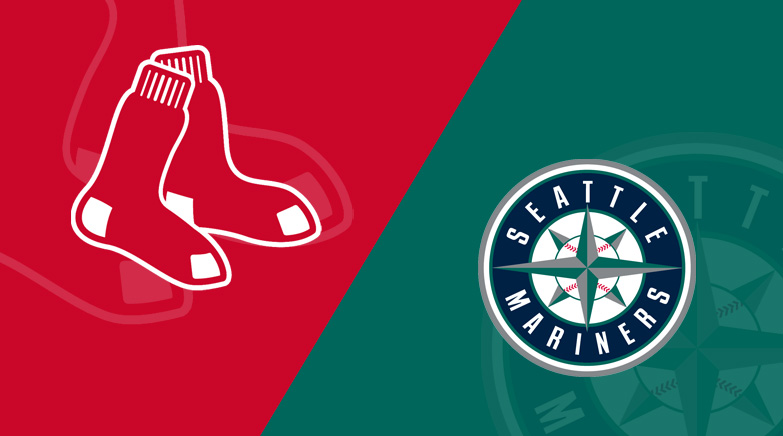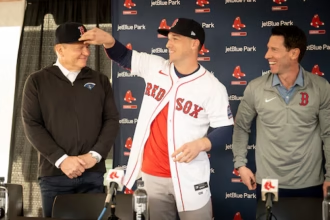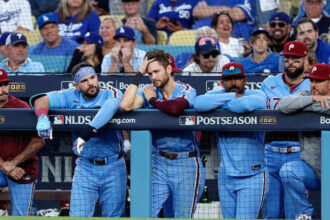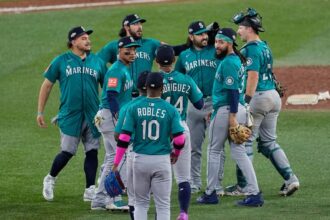The Seattle Mariners are making their intentions very clear when it comes to solving their vacancy at first base there’s no guessing game here. They want Josh Naylor, plain and simple. Naylor was the guy they trusted to hold down first base at the end of the 2025 season, and he’s the player they envision at that position in 2026 and the years that follow. There’s no mystery in the Mariners’ plan, and no effort to disguise it.
However, in baseball, plans rarely unfold exactly as designed. Even with the Mariners’ firm commitment to re-signing Naylor, it doesn’t take much imagination to picture a scenario in which the team is forced to explore alternatives. And if that domino effect occurs, one potential fallback option could be Boston Red Sox slugger Triston Casas a player Seattle has already considered in the recent past.

Just last winter, the Mariners engaged in trade discussions with the Red Sox that revolved around Casas. Boston had interest in Seattle’s young starting pitching, specifically Bryce Miller or Bryan Woo, and proposed parting with Casas as part of a potential deal. The Mariners, however, declined, unwilling to part with their promising young arms. At the time, it looked like a wise decision. While Miller struggled through an uneven 2025 season, Woo emerged as an All-Star and one of the best young starters in the American League. Meanwhile, Casas suffered a major setback when he ruptured his left patellar tendon in May, ending his season prematurely.
On the surface, Seattle’s refusal to trade for Casas appeared to have saved them from a disastrous outcome. But baseball’s landscape shifts quickly, and circumstances now suggest the Mariners might get another opportunity to acquire the Red Sox first baseman and perhaps under more favorable conditions.
A Second Chance at Casas?

Reports that surfaced in July hinted that the Red Sox were growing uncertain about Casas’ long-term future in Boston. Despite his potential, his injuries and inconsistent performance had left the organization questioning whether he could regain his status as a lineup cornerstone. Adding fuel to the speculation, Casas made several cryptic social media posts that stirred curiosity about his mindset and future with the team.
Then came a report from Bob Nightengale of USA Today, who relayed that rival general managers believed Boston could be an ideal landing spot for Mets slugger Pete Alonso. If the Red Sox were to pursue and acquire Alonso, the fit is obvious Alonso would take over first base, leaving Casas without a clear role.

At that point, a trade involving Casas would almost be inevitable. For Seattle, this situation could open a window of opportunity. If Naylor their top target commands a nine-figure contract on the open market, the Mariners might hesitate to engage in a bidding war. That scenario, while not the most likely outcome, is still within the realm of possibility. Should it happen, Seattle’s front office could revisit their previous discussions with Boston about Casas.
Why Casas Still Appeals to Seattle
The appeal of Casas is easy to see, even after his injury. At just 25 years old, he remains under club control through 2028, giving any acquiring team long-term flexibility. While his 2025 numbers were underwhelming a .182/.277/.303 slash line before his season-ending knee injury, the broader picture shows a hitter with significant upside.
In the two seasons before his injury (2023 and 2024), Casas posted a combined 127 OPS+, averaging the equivalent of 31 home runs over a full 162-game season. In 2023, he ranked among the league’s best in underlying metrics, finishing 21st in MLB with a .370 expected weighted on-base average (xwOBA) a strong indicator of quality contact and offensive potential.
Casas’ offensive profile fits exactly what the Mariners typically target: a left-handed bat with legitimate power, good strike zone discipline, and the potential to grow into a middle-of-the-order run producer. There’s swing-and-miss in his game, to be sure, but Seattle’s front office has shown in the past that they can live with strikeouts if the player provides on-base ability and slugging power in return.
What a Trade Could Look Like

If the Red Sox were open to dealing Casas again, the price this time would likely be far lower than it was last winter. Back then, Boston was demanding one of Seattle’s young, controllable starters. Now, given Casas’ injury and the uncertainty surrounding his recovery, the asking price might drop significantly.
The Mariners could even structure a “buy-low” trade — one that benefits both sides by exchanging players who could use a change of scenery. For example, one theoretical framework would be a deal involving Seattle right-hander Luis Castillo.
Boston reportedly showed interest in Castillo last offseason, though talks eventually stalled due to the pitcher’s contract structure and no-trade clause. However, that clause has since expired, removing a major obstacle to a potential deal. Castillo is owed $24.15 million per year for the next two seasons, a hefty sum for a Mariners team looking to maintain financial flexibility.

In this scenario, Seattle could send Castillo to Boston while receiving Casas and perhaps another piece in return. The Red Sox, seeking rotation stability behind Garrett Crochet, would gain a proven starter to anchor their staff. Meanwhile, Seattle would get salary relief, a potential long-term first baseman in Casas, and perhaps a bullpen wild card like Jordan Hicks, who earns about $12.5 million per year and brings elite velocity but inconsistent results.
It’s the type of trade that could make sense for both teams — two franchises addressing positional needs while parting with players who may not fit their future plans. Of course, this remains hypothetical at this point, but it’s a creative framework that could emerge if the stars align.
The Naylor Factor
Still, this entire discussion hinges on what happens with Josh Naylor. The Mariners’ preference is clear: they want to keep the Canadian slugger in Seattle. Naylor’s brief time with the team after the trade deadline showed exactly why he’s such a coveted player. He stabilized the first base position, brought energy to the clubhouse, and delivered clutch hits that fueled Seattle’s late-season playoff push.

The only potential obstacle is cost. Naylor’s combination of power, consistency, and leadership has made him one of the more attractive free agents on the market, and if multiple teams pursue him aggressively, his next contract could stretch beyond $100 million. The Mariners have the resources to compete for him, but they’ll also weigh the long-term financial implications especially with young players like Julio Rodríguez, George Kirby, and Bryan Woo already on significant or upcoming deals.
If Seattle retains Naylor, their problem is solved no trade needed, no contingency plan required. But if they lose him, the fallback plan becomes crucial, and Casas could once again enter the conversation.
What Seattle Would Be Getting
Casas’ blend of youth, power, and control makes him an intriguing option for a Mariners team that values patience and long-term flexibility. He’s not a finished product, but his offensive ceiling is undeniable. From 2023–2024, he showed flashes of becoming one of baseball’s premier young sluggers, and his plate discipline ranks among the best for players his age.

His primary obstacle has been health. The ruptured patellar tendon is a serious injury, and how he recovers will largely determine his trade value. But medical advancements have made it possible for players to return from similar injuries without losing power or explosiveness, and Casas’ youth works in his favor. If the Mariners believe his rehabilitation is progressing well, he could represent a worthwhile gamble especially at a reduced cost.
Seattle has shown a willingness to take calculated risks on players coming off injuries or down years, particularly when there’s long-term upside. They did it with Ty France, Teoscar Hernández, and even Luis Castillo before his contract extension. Casas could fit the same mold: a player whose best baseball might still be ahead of him.
Final Thoughts
At the end of the day, this entire situation could amount to nothing more than offseason speculation the kind of “what if” scenario that fills the void between the final out of the World Series and the opening of spring training. As of now, everything points toward the Mariners doing everything they can to keep Josh Naylor in a Seattle uniform. It’s the move that makes the most sense, satisfies the fan base, and aligns with the front office’s competitive window.
But baseball rarely plays out as expected. Contracts fall through, negotiations stall, and injuries or market shifts force teams to pivot. If Seattle finds itself in that position, the Red Sox and Triston Casas — could once again find themselves in the Mariners’ orbit.
And this time, the dynamics would be completely different. Casas would represent a buy-low, high-upside gamble, while the Red Sox might finally be ready to move on. The Mariners, meanwhile, would get another opportunity to land a left-handed power bat to anchor their lineup.
For now, it’s only speculation. But as the offseason unfolds, and if Naylor’s price tag climbs higher than expected, don’t be surprised if the Mariners’ front office dusts off those old trade notes and places a call back to Boston. After all, in baseball, second chances have a way of appearing when you least expect them and this one could be worth taking.




